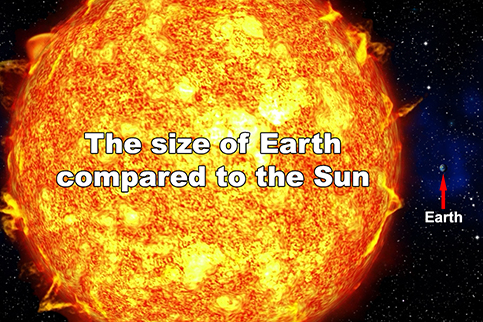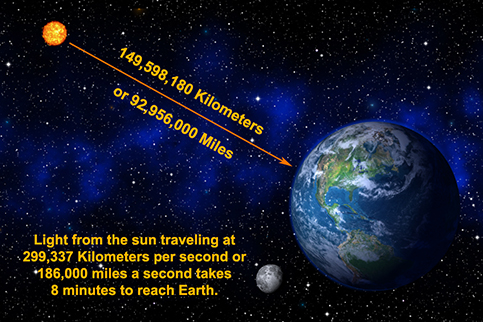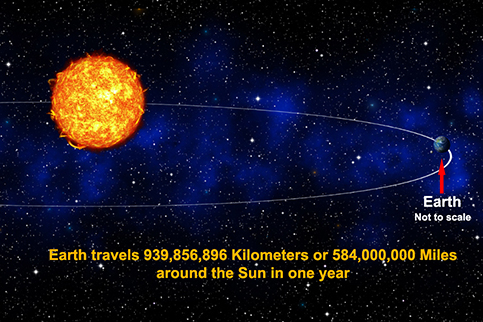Articles
Our Place In The Universe - Part 1

"Our Place In The Universe" is a 4 part series that will explore how our planet, Planet Earth, fits into the grand scheme of things; how it fits into our Solar System, Our Galaxy (The Milky Way) and the Universe.
Planet Earth is the 3rd planet from the Sun and because of this it is sometimes called the "3rd Rock From The Sun". It is also called the "Blue Dot" or the "Blue Planet" because, from space, our planet appears blue. Our Sun is at the center of our Solar System and the Earth, in fact every object in our Solar System, orbits around our Sun. There are 7 other recognized planets in our Solar System as well as numerous Dwarf planets. We will get into more detail about those planets in the Part 2 of this series, for now let's talk about our planet, Earth.
 Earth's Size
Earth's Size
The Earth is, to the best of our knowledge, the only planet in the entire Universe to support life. But that's not to say that there is no other life in our Universe, it's just that we haven't found it yet! We've only been searching for ET for a handful of decades and our Universe is vast! Even our own Solar System is on a scale that can be hard to imagine and our Earth, in comparison, is very small. The Earth is so small that, if the Sun were hollow, 1 million (1,000,000) earth sized planets would fit inside of it! This image gives you a feel for just how small our Earth is compared to our Sun, and our Sun is small compared to many of the stars in our Galaxy!
 Earth's Journey Through Space
Earth's Journey Through Space
Within our Solar System our Earth moves in two ways. First, it spins on its axis and this is what gives us day and night. Imagine spinning a basketball on the tip of your finger; Earth is the ball and your finger is the axis. If you further imagine that your head is the Sun then whichever side of the "ball" is towards you would be basking in your light and would be Day and the opposite side would be Night. The Earth spins on its axis and at the equator, is spinning at a speed of 1,673 km/hour (1,040 miles/hour); a lot faster than you can spin the basketball! Yet even at such a phenominal speed it still takes 24 hours for the Earth to make one complete revolution, or in other words to go from one morning to the next.
In addition to spinning on it's axis the Earth also moves through space; it travels in orbit around the Sun. The Earth orbits the Sun at a staggering 107,826 km/hour (67,000 miles/hour)! Yet even at that speed it still take the Earth 365.25 days to complete one full orbit around the Sun. To adjust for that extra 1/4 day we add 1 day to the calendar every 4 years, February 29th and call that year a leap year. 2016 will be the next leap year. Even though we are travelling around the sun at such a fast speed it takes over 365 days because once complete orbit of the Earth around the sun is 939,856,896 km (548,000,000 miles).
 The Earth orbits the Sun at an average distance of 149, 598,180 km (or 92,956,000 miles). This distance is called an Astronomical Unit (AU) and is used to measure distances throughout our Solar System (more about that in a future post). This is a vast distance, so vast that it helps to think about light to understand just how big a distance it is. The light from the Sun travels at a speed of 299,337 km/second (186,000 miles/second), nothing travels faster than light. If you could travel around the Earth at the equator, at the speed of light, you would go around 7.5 times in 1 second! Yet even at that speed it still takes the light from the Sun 8 minutes to reach the Earth. If you think about it, it's a little like time travel. The light from the Sun that we see here on Earth left the Sun 8 minutes ago. It's like we are in fact seeing 8 minutes into the past.
The Earth orbits the Sun at an average distance of 149, 598,180 km (or 92,956,000 miles). This distance is called an Astronomical Unit (AU) and is used to measure distances throughout our Solar System (more about that in a future post). This is a vast distance, so vast that it helps to think about light to understand just how big a distance it is. The light from the Sun travels at a speed of 299,337 km/second (186,000 miles/second), nothing travels faster than light. If you could travel around the Earth at the equator, at the speed of light, you would go around 7.5 times in 1 second! Yet even at that speed it still takes the light from the Sun 8 minutes to reach the Earth. If you think about it, it's a little like time travel. The light from the Sun that we see here on Earth left the Sun 8 minutes ago. It's like we are in fact seeing 8 minutes into the past.
So to sum it up, even while standing still on Earth, you are spinning at a speed of 1,673 km/hour on a planet that is rockeing through space at 107,826 km/hour. That's a combined speed of 109,499 km/hour (68,000 miles/hour). I bet you didn't know just how fast you were moving! The speed at which our little "Blue Dot" is traveling is staggering, but were not finished yet! So far we have considered the speed at which the Earth is spinning and the speed at which it is orbiting the Sun, but there are two more factors we must consider. The first being the journey of our Solar System through our Milky Way Galaxy and the second being the journey of our Galaxy through the Universe. We will explore both of these in "Our Place In The Universe - Part 2".
Our Earth is sometimes called "the 3rd rock from the Sun" and the "Blue Planet" but I personally like to refer to Earth as "Spaceship Earth". Although we don't feel it, down here on the surface, the truth is that we are travelling through space on the most complex and beautiful Spaceship ever created - Planet Earth. Check back here for more in part 2 of this series.
To learn more about the author click here.


Leave your comments
Post comment as a guest